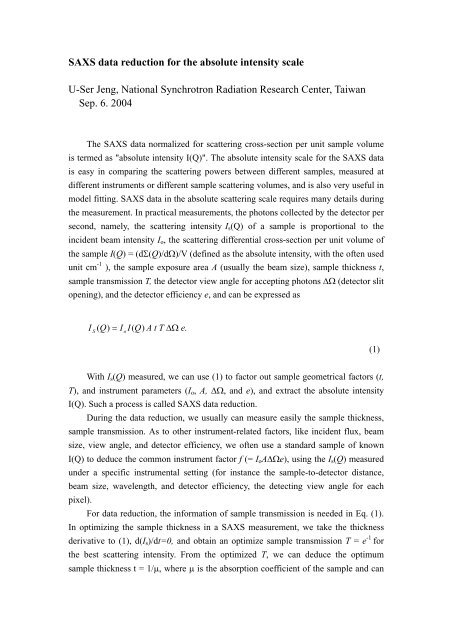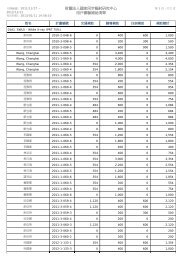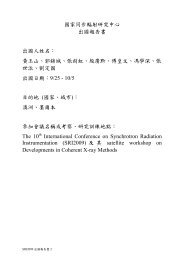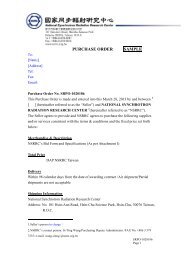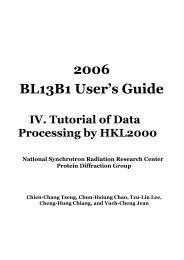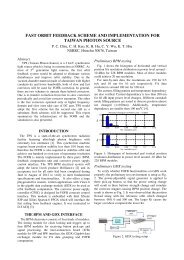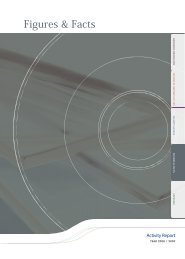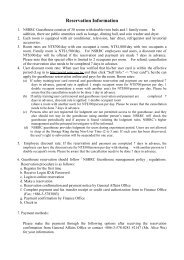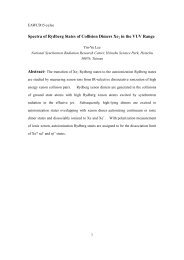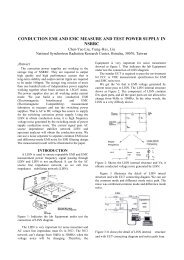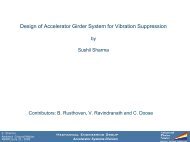SAXS data reduction for the absolute intensity scale
SAXS data reduction for the absolute intensity scale
SAXS data reduction for the absolute intensity scale
Create successful ePaper yourself
Turn your PDF publications into a flip-book with our unique Google optimized e-Paper software.
<strong>SAXS</strong> <strong>data</strong> <strong>reduction</strong> <strong>for</strong> <strong>the</strong> <strong>absolute</strong> <strong>intensity</strong> <strong>scale</strong><br />
U-Ser Jeng, National Synchrotron Radiation Research Center, Taiwan<br />
Sep. 6. 2004<br />
The <strong>SAXS</strong> <strong>data</strong> normalized <strong>for</strong> scattering cross-section per unit sample volume<br />
is termed as "<strong>absolute</strong> <strong>intensity</strong> I(Q)". The <strong>absolute</strong> <strong>intensity</strong> <strong>scale</strong> <strong>for</strong> <strong>the</strong> <strong>SAXS</strong> <strong>data</strong><br />
is easy in comparing <strong>the</strong> scattering powers between different samples, measured at<br />
different instruments or different sample scattering volumes, and is also very useful in<br />
model fitting. <strong>SAXS</strong> <strong>data</strong> in <strong>the</strong> <strong>absolute</strong> scattering <strong>scale</strong> requires many details during<br />
<strong>the</strong> measurement. In practical measurements, <strong>the</strong> photons collected by <strong>the</strong> detector per<br />
second, namely, <strong>the</strong> scattering <strong>intensity</strong> Is(Q) of a sample is proportional to <strong>the</strong><br />
incident beam <strong>intensity</strong> Io, <strong>the</strong> scattering differential cross-section per unit volume of<br />
<strong>the</strong> sample I(Q) = (dΣ(Q)/dΩ)/V (defined as <strong>the</strong> <strong>absolute</strong> <strong>intensity</strong>, with <strong>the</strong> often used<br />
unit cm -1 ), <strong>the</strong> sample exposure area A (usually <strong>the</strong> beam size), sample thickness t,<br />
sample transmission T, <strong>the</strong> detector view angle <strong>for</strong> accepting photons ∆Ω (detector slit<br />
opening), and <strong>the</strong> detector efficiency e, and can be expressed as<br />
I o<br />
S ( Q)<br />
= I I(<br />
Q)<br />
A t T ∆Ω e.<br />
With Is(Q) measured, we can use (1) to factor out sample geometrical factors (t,<br />
T), and instrument parameters (Io, A, ∆Ω, and e), and extract <strong>the</strong> <strong>absolute</strong> <strong>intensity</strong><br />
I(Q). Such a process is called <strong>SAXS</strong> <strong>data</strong> <strong>reduction</strong>.<br />
During <strong>the</strong> <strong>data</strong> <strong>reduction</strong>, we usually can measure easily <strong>the</strong> sample thickness,<br />
sample transmission. As to o<strong>the</strong>r instrument-related factors, like incident flux, beam<br />
size, view angle, and detector efficiency, we often use a standard sample of known<br />
I(Q) to deduce <strong>the</strong> common instrument factor f (= IoA∆Ωe), using <strong>the</strong> Is(Q) measured<br />
under a specific instrumental setting (<strong>for</strong> instance <strong>the</strong> sample-to-detector distance,<br />
beam size, wavelength, and detector efficiency, <strong>the</strong> detecting view angle <strong>for</strong> each<br />
pixel).<br />
For <strong>data</strong> <strong>reduction</strong>, <strong>the</strong> in<strong>for</strong>mation of sample transmission is needed in Eq. (1).<br />
In optimizing <strong>the</strong> sample thickness in a <strong>SAXS</strong> measurement, we take <strong>the</strong> thickness<br />
derivative to (1), d(Is)/dt=0, and obtain an optimize sample transmission T = e -1 <strong>for</strong><br />
<strong>the</strong> best scattering <strong>intensity</strong>. From <strong>the</strong> optimized T, we can deduce <strong>the</strong> optimum<br />
sample thickness t = 1/µ, where µ is <strong>the</strong> absorption coefficient of <strong>the</strong> sample and can<br />
(1)
e found conveniently from <strong>the</strong> website:<br />
www-cxro.lbl.gov/optical_constants/atten2.html. Stable materials with high scattering<br />
<strong>intensity</strong>, <strong>for</strong> instance polyethylene (PE) of a known peak value I(Q) = 36.6 cm -1 at Q<br />
= 0.0223 Å -1 , can be used as secondary standard samples (see Figure 18). With a<br />
standard sample of known <strong>absolute</strong> I(Q) measured at a <strong>SAXS</strong> instrument, we can<br />
measure all o<strong>the</strong>r related quantities in (1), and determine <strong>the</strong> f factor <strong>for</strong> <strong>the</strong> <strong>SAXS</strong><br />
instrument configuration. Using this f factor in (1) <strong>for</strong> o<strong>the</strong>r samples, we can put <strong>the</strong><br />
scattering <strong>intensity</strong> of <strong>the</strong> samples in <strong>the</strong> <strong>absolute</strong> scattering <strong>intensity</strong> <strong>scale</strong> I(Q).<br />
In practical <strong>data</strong> <strong>reduction</strong>, we still need to consider <strong>the</strong> subtraction of<br />
background scattering, electronic dark current, and correction <strong>for</strong> <strong>the</strong> detector pixel<br />
efficiency. For a normalization <strong>for</strong> <strong>the</strong> time-dependent incoming flux <strong>for</strong> each<br />
measurement, we modify (1) to <strong>the</strong> following:<br />
dΣ(<br />
Q)<br />
I(<br />
Q)<br />
=<br />
dΩ<br />
1<br />
T<br />
s d s emp<br />
d emp<br />
fTmt<br />
Temp<br />
⎥ ⎥ ⎛ ⎞⎡<br />
⎤<br />
= ⎜<br />
⎟<br />
⎟⎢<br />
⎝ ⎠⎢⎣<br />
⎦<br />
(2)<br />
m<br />
( I ( Q)<br />
−cI<br />
( Q)<br />
) / i − ( I ( Q)<br />
−c"<br />
I ( Q)<br />
) / i / I ( Q)<br />
In (2), is, and iemp are <strong>the</strong> monitor counts of <strong>the</strong> incoming beam intensities <strong>for</strong> <strong>the</strong><br />
sample and background <strong>SAXS</strong> measurements. Whereas c and c'' are <strong>the</strong> time ratios of<br />
<strong>the</strong> sample and background scattering measurements to <strong>the</strong> dark current measurement,<br />
respectively. Tm is <strong>the</strong> sample transmission measured and Tem is <strong>the</strong> transmission<br />
measured without sample (air or pure solvent used), whereas Isen(Q) is <strong>the</strong> detector<br />
efficiency <strong>for</strong> <strong>the</strong> corresponding detector pixel. The working procedure <strong>for</strong> <strong>the</strong> <strong>data</strong><br />
<strong>reduction</strong> is detailed in <strong>the</strong> appendix A5.<br />
sen
PE Absolute Intensity dΣ(Q)/dΩ (cm -1 )<br />
10<br />
1<br />
0.1<br />
0.05 0.10<br />
Q (Å -1 )<br />
Figure 18. The commonly used high density polyethylene sample <strong>for</strong> <strong>the</strong> <strong>absolute</strong><br />
<strong>intensity</strong> calibration, with a well calibrated <strong>intensity</strong> at I (Q = 0.0223 Å -1 ) = 36.5 cm -1 .


